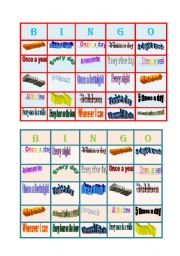
|
Bingo - epressions of frequency
DIRECTIONS
Bingo is a game where students place a marker on every correct matching answer to the question. The card usually has 25 squares. When a student has the answer to the question being asked, he places his marker (a coin, colored circle or game piece) on the rectangle with the answer. When a student gets 5 answers in a row, he wins the bingo game and announces Bingo! The rows can be across, down, or diagonal. The students have to invent questions (or the teacher). Cut out the questions and fold the strips of paper in half so the student cannot see the question. Put all the pieces of folded paper with the questions in a box, jar, or hat. Choose a student to pick a question out of the container and have him read the question aloud. Everyone who has that question answered on his Bingo card, places a marker on the answer. The student chooses who will pick the next piece of paper and read its question aloud to the class.(Alternately, the teacher can do all the drawing of questions and reading of the questions. The teacher can also make up the questions himself, depending on the level of the students, if he thinks it is too hard for them). Included are four Bingo cards. You can make it a team activity here you divide the class into two teams, and the first team to get five in a row wins. Or you can make it a pair activity where students take turns asking each other the questions and the first one to get 5 in a row wins. Or it can be a whole class activity as suggested above. Three sets of 25 questions each are included for teachers who prefer ready made materials. A black and white Bingo template is included in case you want students to be creative and make and decorate their own bingo cards.
Level:elementary
Age: 7-17
Downloads:20 |
|
Copyright 16/5/2010 Mary
Publication or redistribution of any part of this
document is forbidden without authorization of the
copyright owner.
|


see more worksheets by redcamarocruiser
|